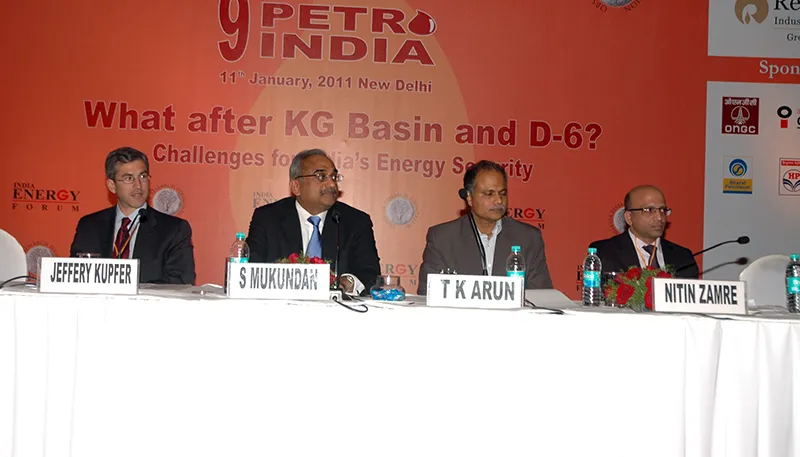Studies done in ORF estimate that even with everything in our favour, India will be hard put to exceed a thermal coal based capacity beyond 300 GW. In such a scenario, how do we better harness our oil and gas potential and fulfill the great promise that lies hidden in our vast unexplored acreages.

To recall, the last time we had assembled this forum for the 8th Petro India was Nov 2009. This was in the wake of Economic Downturn and the subject was “Managing Volatility and Growth in the Hydrocarbon Sector”.
However, in retrospect 2009 turned out to be significant for some very different reasons as well. It marked the year which for the first time since 1946 showed a decline in global GDP. But even more significant than this decline was the fact that China and India even more emphatically powered ahead to lead the shift in the centre of gravity of the world economy. This shift by now has been a whole decade in the making.
The year also continued the phenomenal growth of non-conventional gas in the US. Thus a country which was seen to be eyeing increasing LNG imports only two years ago has today become self sufficient thanks to developments in shale gas.
These developments put the brakes on several planned LNG capacity additions as LNG virtually overnight moved from a sellers to a buyers market. Projections are that the global over supply of natural gas could well last up to 2015 or longer depending on recovery from the recession or more significantly as demand soars in China and India.
These dramatic changes in the global market have continued to bring unforeseen advantages to countries which built large dependencies on natural gas as it traded and continues to trade at a significant discount to oil.
The laggards here have unfortunately been China and India.
China and India, both highly coal dependent countries have been long plagued by underdeveloped gas markets that have hampered the growth of investments not only in the extraction and production of domestic gas resources but also in the infrastructure needed to tie up and bring gas imports into these countries as either LNG or trans-national piped gas.
However, 2009 did indeed also marked a transition point for India’s gas sector. Consumption jumped 60% to touch 160 mmscmd. Yet, belying all expectations that production from RIL’s block would spell the death knell of expensive LNG, the country still imported 34 MMSCMD of LNG and is which was actually 12% more than the previous year. Already it is showing a voracious appetite for ever more.
Energy markets in China and Indian have had many similarities. Both have been late entrants into the international gas markets setting up their first LNG terminals only in 2004. For years Regulatory ambivalence has led to a far lower level of infrastructure development than even neighboring Pakistan. However while China has already begun transporting gas across trans-national pipelines from Central Asia India has yet to make any significant headway in this regard. India’s supposedly huge gas market has remained more of a mirage where demand projections range from 200 to 500 mmscmd based on speculative conjectures about future gas policy and regulation.
Even as India powers ahead, the bad news is that seven years in a row have passed without any significant gas discovery of a size comparable to KG D-6 – and this too in spite of over 200 blocks under active exploration following India’s New Exploration Licensing Policy (NELP).
The aim of this Conference has therefore been to debate some of the imperatives posed by these questions.
KG D-6 gas starts declining post 2017 which could be well after the current LNG glut has ended. With large deep sea projects taking eight to ten years for commissioning after discovery, there is reason to be worried as the country’s highest ever gas output is already leading to dependencies which consumers will find extremely difficult to be weaned away from.
India’s declarations on a 25% cut in its emissions intensity by 2020 also seem do-able only if there is a concerted shift from coal to natural gas for producing power. Moreover there seem major constraints on how far coal based power can take us further down the road to an energy secure future.
Already in 2009 China produced over 45% of the world’s coal as it registered an increase of 9% over the previous year. India’s coal production at 560 MMT, a fifth of China’s, also registered a comparable growth of 8.4 %. Yet these countries have become increasingly huge importers of coal. India imported 67 MMT of coal in 2009 of which 44 MMT was steam coal whereas Chinese coal imports during the same year more than doubled to 137 MMT (102 MMT of steam coal) led by a surge in demand as a result of the country’s stimulus package.
With these two countries alone making up for 22% of the total global coal trade they are clearly emerging as key pivots forcing movements in international coal prices.
Studies done in the ORF estimate that even with everything in our favour India will be hard put to exceed a thermal coal based capacity beyond 300 GW. This is so because attaining these levels brings us to a point where RP ratios decline to 30 automatically capping any further major capacity addition beyond this level.
Landed prices for imported coal today are over $ 5 per mmbtu as the deluge in Queensland pushes thermal coal prices to $ 135 and coking coal over $225.
How do we better harness our own potential and fulfill the great promise that lies hidden in our vast unexplored acreages which definitely show signs of being far more gas rather than oil prone?
How to best promote investments and technology induction in conventional as well as un-conventional gas resources?
What policy and regulatory frameworks can better integrate fuel and feedstock markets and bring in greater transparency?
How do we evolve into a market that can encourage consumers to make the most efficient and productive choices relating to use of fuel or feedstock?
How can we reconcile a very high import dependency with our internal preference and pressures for continuing with highly cocooned, segmented and closed markets?
And in the final analysis do we need to take a more comprehensive view of Energy Security?
The views expressed above belong to the author(s). ORF research and analyses now available on Telegram! Click here to access our curated content — blogs, longforms and interviews.




 PREV
PREV

